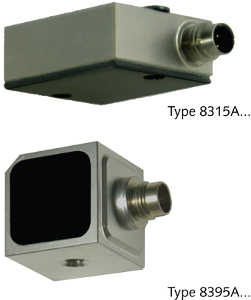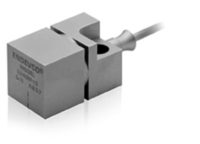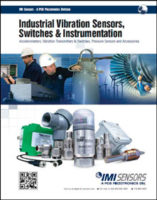 Kistler (www.kistler.com), a worldwide supplier of precision sensors, systems and instrumentation for the dynamic measurement of pressure, force, torque and acceleration, has introduced its K-Beam® high-sensitivity, low-noise MEMS capacitive accelerometer family. The K-Beam® family is designed to support single axis and triaxial measurement requirements, particularly where use of an instrument-grade accelerometer for high-precision, low-frequency measurements is required. The K-Beam® family is offered in ranges from ±2 g to ±200 g and with frequency response from DC to 1000 Hz (5%). Accelerometers are available in four different models of either single axis (Type 8315A) or triaxial (Type 8395A) versions and incorporate a MEMS variable capacitance sensing element, consisting of a small inertial mass and flexure element sandwiched between two parallel plates (electrodes). As the mass deflects under acceleration, the capacitance between the sensing element and plates changes, which is then converted to a proportional voltage by the internal analog signal conditioner. All units offer excellent thermal stability and reliability over an operating temperature range of -65°F to +250°F (-55°C to +125°C), with 6,000 g pk shock survivability.
Kistler (www.kistler.com), a worldwide supplier of precision sensors, systems and instrumentation for the dynamic measurement of pressure, force, torque and acceleration, has introduced its K-Beam® high-sensitivity, low-noise MEMS capacitive accelerometer family. The K-Beam® family is designed to support single axis and triaxial measurement requirements, particularly where use of an instrument-grade accelerometer for high-precision, low-frequency measurements is required. The K-Beam® family is offered in ranges from ±2 g to ±200 g and with frequency response from DC to 1000 Hz (5%). Accelerometers are available in four different models of either single axis (Type 8315A) or triaxial (Type 8395A) versions and incorporate a MEMS variable capacitance sensing element, consisting of a small inertial mass and flexure element sandwiched between two parallel plates (electrodes). As the mass deflects under acceleration, the capacitance between the sensing element and plates changes, which is then converted to a proportional voltage by the internal analog signal conditioner. All units offer excellent thermal stability and reliability over an operating temperature range of -65°F to +250°F (-55°C to +125°C), with 6,000 g pk shock survivability.
The Type 8315A single axis version features a 1-inch (25.4 mm) footprint and is powered by a single wide range supply between +6 and +50 VDC. The six available Type 8315A models are offered with three different housing and electrical interface options (AC, TA, TB), which determine available output signal formats. The AC option features a lightweight, hard anodized aluminum housing with environmental sealing, integral ground isolation, epoxy seal and integral PVC cable, with a maximum operating temperature of +185°F (+85°C). Available AC option output signal formats are bipolar at 0±4V; single ended 2.5V±2V; or differential 0±8V. Series TA and TB options feature lightweight, welded titanium housings with choice of 4-pin, ¼-28 connector or integral Teflon jacketed cable, for a fully hermetic design with integral ground isolation. Temperature output is also provided, should external temperature compensation be desired. The TA and TB options have an operating temperature range of -65°F to +250°F (-55°C to +125°C).
The Type 8395A triaxial version is designed to simultaneously measure acceleration and low-frequency vibration in three mutually perpendicular axes (x, y and z), with a compact design that occupies a 0.85-inch (21.6 mm) cube footprint. The output format of the Type 8395A series is bipolar at 0±4V and provides a high-sensitivity, low-noise signal, compatible with a wide variety of data acquisition or readout devices. Sensing elements and integral electronics are housed within a lightweight, welded titanium housing with a specially designed miniature circular 9-pin connector, for a fully hermetic design. It is powered by a single wide range supply between +6 and +50 VDC. In the event that external temperature compensation is desired for the application, a temperature output is provided, in addition to output signals. Ground isolation is obtained by mounting the sensor using off-ground accessories or by adhesive mounting to the test object using the side of the sensor with the integral hard anodized plate.



